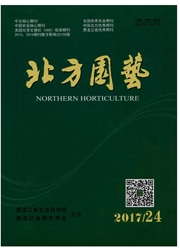

 中文摘要:
中文摘要:
以经引种驯化后的"红灯"大樱桃(Cerasus avium‘Hongdeng’)耐寒植株的茎尖、腋芽和带腋芽的幼嫩茎段为外植体,对其组培快繁体系进行了比较系统的研究。结果表明:"红灯"大樱桃茎尖及茎段外植体在MS+6-BA 0.8mg/L+NAA 0.02mg/L+3%Sucrose+AC 0.5g/L+0.7%Agar(pH 5.8)培养基上,芽萌发、生长状况较好,萌发率高达90.0%;其组培苗在MS+6-BA 0.6mg/L+NAA 0.02mg/L+GA30.1mg/L+维生素C 40mg/L+3%Sucrose+0.7%Agar(pH 5.8)培养基上继代培养25d左右,继代增殖系数均可达到3.0左右;将其中长势良好的组培苗在1/2MS+NAA 0.8mg/L+1.5%Sucrose+0.7%Agar(pH 5.8)培养基上生根壮苗培养后,移栽成活率可达86.7%。
 英文摘要:
英文摘要:
Taking stem apex,axillary buds and young stems with axillary buds from the cold-tolerant plants of Cerasus avium ' Hongdeng' after acclimatization as explants,the protocol of rapid propagation by tissue culture was groped. The results showed that 90% of adventitious buds germinated on the primary medium contained MS basal salts and vitamins, 6-BA 0. 8 mg/L,NAA 0. 02 mg/L,AC 0. 5 g/L and 3% sucrose which was solidified with 0. 7% agar(pH 5.8). After the shoots in vitro were subcultured for 25 days and so on the subculture medium contained 6-BA 0. 6 mg/L,NAA 0. 02 rag/L, GA~ 0. 6 mg/L,vitamin C 40 mg/L,the propagation coefficient by subculture could he up to 3. 0. The shoots were rooted and grew stronger the 1/2 MS medium contained NAA 0. 8 mg/L,vitamin C 40 mg/L and 1.5% sucrose,and 86. 7% of shoots with strong roots survived after they were transplanted to soil.
 同期刊论文项目
同期刊论文项目
 同项目期刊论文
同项目期刊论文
 期刊信息
期刊信息
